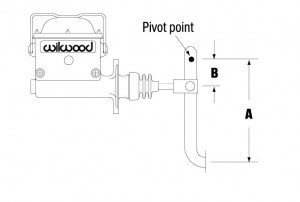Mailbag: How to Calculate Brake Pedal Ratio and Master Cylinder Size
Q: I’m putting together a disc brake system for a custom build. What can you tell me about setting up brake pedal ratio for optimum performance? Also, what can you tell me about master cylinders? Specifically, what do I need to know about the bore size of the master cylinder?
A: On average, brake pedal ratio should range from 5.1:1 to 7.1:1. To calculate your ratio, measure the distance from the pivot point of the pedal to the center of the pedal pad (measurement A), and then the  distance between the pivot point and the master cylinder pushrod hole (measurement B). Next, divide measurement A by measurement B. If A=14 inches and B=2.3 inches, your ratio is 6.08:1 (14/2.3=6.08). Increasing the pedal ratio increases leverage and pedal travel. Conversely, decreasing the ratio yields less leverage and pedal travel along with increased pedal effort. Make sure the master cylinder pushrod angle does not exceed 5 degrees while setting up your pedal ratio.
distance between the pivot point and the master cylinder pushrod hole (measurement B). Next, divide measurement A by measurement B. If A=14 inches and B=2.3 inches, your ratio is 6.08:1 (14/2.3=6.08). Increasing the pedal ratio increases leverage and pedal travel. Conversely, decreasing the ratio yields less leverage and pedal travel along with increased pedal effort. Make sure the master cylinder pushrod angle does not exceed 5 degrees while setting up your pedal ratio.
A properly engineered brake system should deliver sufficient fluid volume to produce a firm, responsive pedal while generating enough pressure to stop your vehicle comfortably. A typical disc brake system requires between 900 and 1,200 psi at the brake caliper (as measured with a pressure gauge). Most master cylinders have a bore size of 5/8-inch to 1 1/8-inch. Larger-bore master cylinders move a high volume of brake fluid, at lower pressure with less pedal travel. A smaller bore moves less fluid at higher pressure with increased pedal travel. If fluid pressure at the caliper measures low, reducing the master cylinder’s bore size will increase pressure and vice-versa.
…





Could we get an article on finding the right tire pressure for custom cars? Obivously adding or removing weight will effect optimum pressure. But does changing tire size?